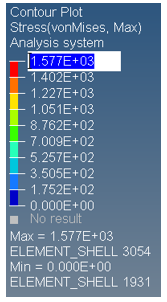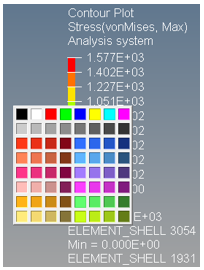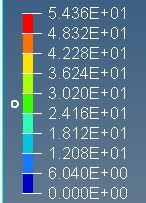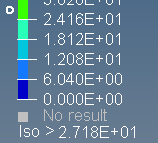Graphical Editing of the Legend and Iso-slider |

|

|

|

|
|
Graphical Editing of the Legend and Iso-slider |

|

|

|

|
You can edit the contour, vector, or tensor plot legend either in the graphics area or by using the Edit Legend dialog (which is accessed by clicking the Edit Legend button on the Contour, Tensor, and Vector panels). For details on editing the legend using latter method, please refer to the Edit Legend topic.
The values and colors of the legend can be edited in-place directly on the legend itself. Simply left-click on the value to enter the edit mode and type in the desired value.

Similarly, left-click on the color to bring up the color palette and select the desired color.

| Note | In the case of a dynamic legend, values cannot be changed. |
In-place legend editing is available only for numerical legends. In the case of category legends, please use the Edit Legend dialog. Refer to the Edit Category Legend topic for details.
In addition to in-place editing, a legend context menu is also provided for quick access to various legend options. Right-click on the legend area to bring up a context menu with options to edit the type, position, numeric format, and display settings of the legend. To access additional options, click on Edit Legend in the context menu. Refer to the Legend Context Menu topic for additional details on menu options.
The legend context menu also provides a convenient way to create an iso plot (based on the contour settings) and control its display from the contour legend itself without having to do so from the Iso panel. From the legend context menu, click on iso > Add plot.
This will create an iso plot that uses the contour settings and:
| a. | Place a slider on the left of the contour legend values. |

The slider can be dragged vertically up and down by clicking and holding the left mouse button down and moving the mouse to control the display on the screen.
| b. | Create a label Iso followed by a Show Values mode (=,>, or <) and value in the legend. |

You can left click directly on the mode to cycle through the various options (Equal, Above, or Below) and set the desired mode.
Equal |
Updates the graphics display so that all elements with result values equal to the current iso surface level are displayed (unmasked) based on their display attributes defined on the Entity Attributes panel. |
Above |
Updates the graphics display so that all elements with result values above the current iso surface level are displayed (unmasked) based on their display attributes defined on the Entity Attributes panel. |
Below |
Updates the graphics display so that all elements with result values below the current iso surface level are displayed (unmasked) based on their display attributes defined on the Entity Attributes panel. |
Left-click on the value to enter the edit mode and then type in the desired iso-value.
Additional iso settings can be accessed through Iso option in the legend context menu. Refer to Legend Context Menu topic for additional details.
| Note | The iso created through the legend context menu will use the contour settings to create an iso-plot. This is same as using the Use Contour Settings option in the Iso panel to create an iso-plot. |
After creating an iso-slider, updating the contour by changing some settings may cause a mismatch between the contour plot and the iso-plot. In such cases, the iso-slider will automatically be removed from the legend and you can then only control the iso plot through the Iso panel.